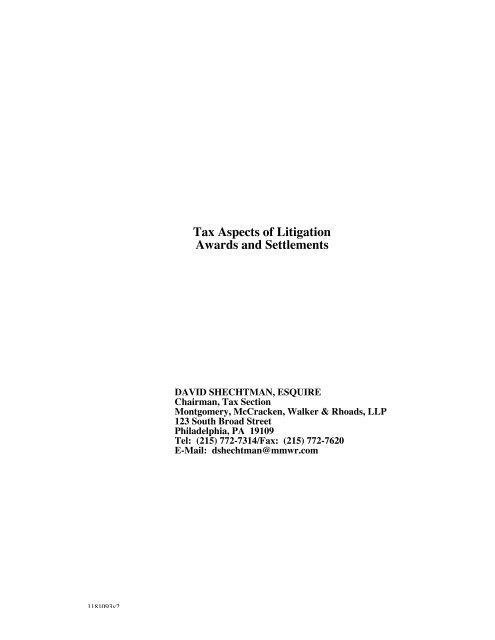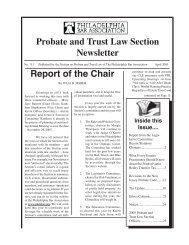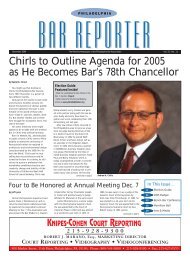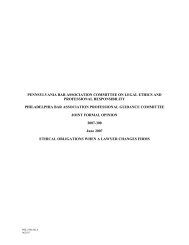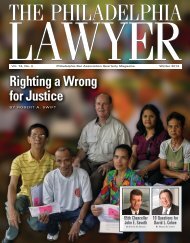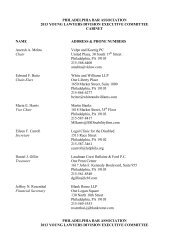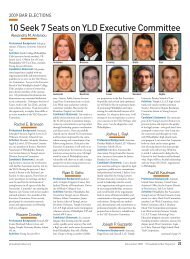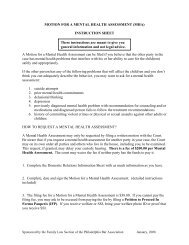Tax Aspects of Litigation Awards and Settlements - Philadelphia Bar ...
Tax Aspects of Litigation Awards and Settlements - Philadelphia Bar ...
Tax Aspects of Litigation Awards and Settlements - Philadelphia Bar ...
Create successful ePaper yourself
Turn your PDF publications into a flip-book with our unique Google optimized e-Paper software.
<strong>Tax</strong> <strong>Aspects</strong> <strong>of</strong> <strong>Litigation</strong><br />
<strong>Awards</strong> <strong>and</strong> <strong>Settlements</strong><br />
DAVID SHECHTMAN, ESQUIRE<br />
Chairman, <strong>Tax</strong> Section<br />
Montgomery, McCracken, Walker & Rhoads, LLP<br />
123 South Broad Street<br />
<strong>Philadelphia</strong>, PA 19109<br />
Tel: (215) 772-7314/Fax: (215) 772-7620<br />
E-Mail: dshechtman@mmwr.com<br />
1181093v2
I. GENERAL INCOME TAX RULES<br />
A. Settlement or Judgment. The tax consequences <strong>of</strong> a payment<br />
made in connection with a lawsuit are the same whether the<br />
lawsuit is settled or proceeds to judgment. Either type <strong>of</strong> payment<br />
is referred to herein as an “Award”.<br />
B. Origin <strong>of</strong> Claim. In general, the origin <strong>of</strong> the claim presented in<br />
the lawsuit determines the tax consequences <strong>of</strong> the Award. A<br />
plaintiff’s tax treatment is determined by reference to the genesis<br />
<strong>and</strong> gravamen <strong>of</strong> the underlying claims. U.S. v. Gilmore, 372 U.S.<br />
39 (1963); U.S. v Woodward, 397 U.S. 572 (1970); Keller St. Dev.<br />
Co. v. Comm’r, 688 F.2d 675 (9th Cir. 1982). Often, however,<br />
lawsuits involve multiple claims <strong>and</strong> complex facts.<br />
1. Lost Pr<strong>of</strong>its Versus Goodwill. Claims which arise in a<br />
business context <strong>of</strong>ten involve elements relating to both lost<br />
pr<strong>of</strong>its <strong>and</strong> damage to identifiable assets, such as goodwill.<br />
The burden is on the taxpayer to demonstrate the existence<br />
<strong>of</strong> an asset, as well as damage thereto, in order to avoid<br />
treatment <strong>of</strong> an Award as ordinary income. Rev. Rul. 75-<br />
527, 1975-2 C.B. 30. Raytheon Corp. v. Comm’r, 144 F.2d<br />
110 (1st Cir. 1944). See also Messer v. Comm’r, 438 F.2d<br />
774 (3d Cir. 1971); Milenbach v. Comm’r, 318 F.3d 924<br />
(9th Cir. 2003) rev’g in part 106 T.C. 184 (1996) ($4<br />
million received by Oakl<strong>and</strong> Raiders from City <strong>of</strong> Oakl<strong>and</strong><br />
in settlement for damage claim stemming from the two<br />
years the team was prevented from moving to Los Angeles<br />
treated as substitute for lost income).<br />
2. Return <strong>of</strong> Capital. To the extent that the amount received<br />
for damage to an identifiable asset does not exceed the<br />
taxpayer’s basis in the asset, the Award is treated as a<br />
nontaxable return <strong>of</strong> capital, which decreases the remaining<br />
basis in the asset. Rev. Rul. 81-277, 1981-2 C.B. 14;<br />
Daugherty v. Comm’r, 78 T.C. 623 (1982).<br />
3. <strong>Awards</strong> in Excess <strong>of</strong> Basis. Existing case law is not clear<br />
on the issue <strong>of</strong> whether an Award in excess <strong>of</strong> basis with<br />
respect to a capital asset is taxable as ordinary income or as<br />
capital gain. Compare Fahey v. Comm’r, 16 T.C. 105<br />
(1951) (no capital gain because no “sale or exchange”) with<br />
Durkee v. Comm’r, 181 F.2d 189 (6th Cir. 1950) (award<br />
for destruction <strong>of</strong> zero-basis goodwill taxable as capital<br />
gain even in the absence <strong>of</strong> a demonstrable sale or<br />
exchange). See also, Turzillo v. Comm., 346 F.2d 884 (6th<br />
Cir. 1965) (inquiry into “sale or “exchange” found<br />
“formalistic,” Award for breach <strong>of</strong> agreement to acquire<br />
shares held taxable as capital gains); Inco Electroenergy v.<br />
Comm’r, T.C.M. 1987-437 (1987) (capital gain where<br />
1181093v2
Award in trademark litigation found to be compensation for<br />
damage to trademark <strong>and</strong> goodwill).<br />
4. Recent Developments. Most recently in Steel, T.C.M.<br />
2002-113, the <strong>Tax</strong> Court emphasized the “sale or<br />
exchange” requirement in treating as ordinary income the<br />
settlement <strong>of</strong> an insurance claim assigned to the taxpayers<br />
by a corporation. The court also rejected the taxpayer’s<br />
argument that the distribution <strong>of</strong> the claim should be<br />
integrated with a sale <strong>of</strong> the distributing corporation’s stock<br />
occurring shortly thereafter. The distinction between<br />
capital gain <strong>and</strong> ordinary income has grown more<br />
significant after the passage <strong>of</strong> the Jobs <strong>and</strong> Growth <strong>Tax</strong><br />
Relief Reconciliation Act <strong>of</strong> 2003 (“JGTRRA”) which<br />
reduced the maximum tax rate on capital gains for<br />
individuals to 15%.<br />
5. Acquired Legal Claims. Recent opinions <strong>of</strong> the Seventh<br />
Circuit <strong>and</strong> the <strong>Tax</strong> Court suggest that a different rule may<br />
apply to settlement <strong>of</strong> an acquired legal claim. Nahey v.<br />
Comm’r, 196 F.3d 866 (7th Cir. 1999) aff’g 111 T.C. 256<br />
(1998). The taxpayer in Nahey acquired all the assets <strong>of</strong> a<br />
corporation, including a breach <strong>of</strong> contract claim against<br />
Xerox related to installation <strong>of</strong> a new computer system.<br />
Without addressing the “origin” <strong>of</strong> the claim against Xerox,<br />
both courts concluded that taxpayer necessarily realized<br />
ordinary income because the extinguishment <strong>of</strong> the claim<br />
did not amount to a sale or exchange. One commentator<br />
has suggested that the Seventh Circuit <strong>and</strong> <strong>Tax</strong> Court’s<br />
holding is “incompatible with” the origin <strong>of</strong> the claim<br />
doctrine. See David B. Flassing, From Fahey to Nahey:<br />
W<strong>and</strong>ering Off the Origin <strong>of</strong> Claim Path in Settlement <strong>of</strong><br />
Acquired Legal Claims, TAXES – THE TAX MAGAZINE,<br />
Aug. 2002, at 35. The Nahey rule also suggests that a<br />
plaintiff may recognize capital gain on any sale <strong>of</strong> a claim<br />
to a third party.<br />
6. Involuntary Conversion. In FSA 200217001, the IRS<br />
held that an Award for breach <strong>of</strong> contract <strong>and</strong> tortious<br />
interference was not an involuntary conversion for<br />
purposes <strong>of</strong> I.R.C. § 1033, finding that no theft occurred<br />
due to the lack <strong>of</strong> criminal activity.<br />
7. Claims for Lost <strong>Tax</strong> Benefits. In Clark v. Comm’r, 40<br />
B.T.A. 333 (1939), acq. 1957-2 C.B. 4, <strong>and</strong> Rev. Rul. 57-<br />
47, 1957-1 C.B. 3 the <strong>Tax</strong> Court held (<strong>and</strong> the IRS<br />
ultimately agreed) that a payment made by a tax<br />
practitioner to reimburse a client who had overpaid taxes<br />
due to faulty advice was not includible in the taxpayer’s<br />
income. The holdings were premised on a variant <strong>of</strong> the<br />
tax benefit rule – i.e., recovery on a non-deductible<br />
1181093v2<br />
2
expenditure (federal income taxes paid) should not produce<br />
income. See also, Concord Instruments Corp. T.C.M.<br />
1994-248 (malpractice award received by taxpayer due to<br />
attorney’s failure to timely appeal adverse <strong>Tax</strong> Court<br />
decision allocated between non-taxable portion for<br />
additional tax owned <strong>and</strong> taxable portion for interest owed.)<br />
In a series <strong>of</strong> private rulings, however, the IRS has tried to<br />
narrow the scope <strong>of</strong> Clark. In the IRS’ view, where a third<br />
party reimburses a taxpayer for income taxes paid, the<br />
reimbursement will constitute income – unless the<br />
difference is the result <strong>of</strong> payment <strong>of</strong> more tax than the<br />
minimum that would have been due absent return<br />
preparation errors. See PLR 9226033 (where taxpayer paid<br />
no more than minimum amount <strong>of</strong> tax properly due,<br />
taxpayer is taxable on breach <strong>of</strong> contract damages due to<br />
misrepresentation <strong>of</strong> tax consequences on securities found<br />
ineligible for Section 936 credit <strong>and</strong> a lease found ineligible<br />
for safe harbor lease status). For a discussion <strong>of</strong> the<br />
distinction between Clark <strong>and</strong> the 1992 private rulings in<br />
the context <strong>of</strong> damage determination (i.e., the need for a<br />
“gross up”) see Centex Corp. v. U.S., 55 Fed. Cl. 381 (Fed.<br />
Cl. Ct. 2003).<br />
C. Limitation on Origin <strong>of</strong> the Claims Doctrine. Even if a claim<br />
arises out <strong>of</strong> an item, the receipt <strong>of</strong> which would have been tax-free<br />
to the plaintiff, the receipt <strong>of</strong> an Award may not be tax-free unless<br />
all requirements <strong>of</strong> the applicable Code Section are met. For<br />
example, in PLR 200528023 (released 7/15/05), the IRS analyzed<br />
settlement payments made by a corporation to the estates <strong>of</strong><br />
various former employees <strong>of</strong> the corporation. Unbeknownst to the<br />
employees, the corporation had purchased insurance on their lives<br />
with the corporation named as the beneficiary. Although life<br />
insurance proceeds are generally excluded form income under<br />
Code §101(a), the IRS held that the settlements received were<br />
taxable as a recovery <strong>of</strong> “converted funds” because they were<br />
received from the corporation, not the insurance company, <strong>and</strong><br />
were less than the amount <strong>of</strong> the death benefit.<br />
II.<br />
INCOME TAX CONSEQUENCES ARISING FROM PERSONAL<br />
INJURY CLAIMS<br />
A. Workmen’s Compensation. Amounts received under workmen’s<br />
compensation acts as compensation for personal injuries or<br />
sickness are not taxable. I.R.C. §104(a)(1).<br />
B. Personal Physical Injuries or Physical Sickness. Under current<br />
law, amounts received for personal physical injuries or physical<br />
sickness are not taxable, whether the Award is paid in a lump sum<br />
or in installments. I.R.C. §104(a)(2). See, I.R.C. §130 regarding<br />
“qualified assignments” <strong>of</strong> defendant’s liability to make periodic<br />
1181093v2<br />
3
payments <strong>of</strong> personal injury <strong>Awards</strong> through the purchase <strong>of</strong><br />
“qualified funding assets.”<br />
1. Prior Law Background. Historically, I.R.C. §104<br />
excluded damages received for all (not just physical)<br />
personal injuries. Many traditional “dignatory” torts (e.g.<br />
defamation, intentional infliction <strong>of</strong> emotional distress)<br />
were held to result in excludable <strong>Awards</strong>. See e.g.,<br />
Threlkeld v. Comm’r, 87 T.C. 1294 (1986), aff’d 848 F.2d<br />
81 (6 th Cir. 1988) (<strong>Awards</strong> for injury to reputation are<br />
excludable whether personal or pr<strong>of</strong>essional reputation is<br />
involved).<br />
2. Employment Law Claims Under Prior Law. At one<br />
time, wrongful termination <strong>and</strong> various employment<br />
discrimination claims were held to result in excludable<br />
<strong>Awards</strong> based upon the “tort-like” nature <strong>of</strong> the claim. See,<br />
e.g., Redfield v. Ins. Co. <strong>of</strong> North America, 940 F.2d 542<br />
(9 th Cir. 1991).<br />
3. Schleier St<strong>and</strong>ard. In Comm’r v. Schleier, 515 U.S. 323<br />
(1995), the U.S. Supreme Court held that an Award under<br />
ADEA (federal age discrimination statute) was taxable.<br />
The Court applied a new two-part test which substantially<br />
narrowed the scope <strong>of</strong> then-applicable I.R.C. §104(a)(2).<br />
These tests require that for an Award to be excludable it<br />
must be (1) received through prosecution <strong>of</strong> tort or tort-type<br />
rights <strong>and</strong> (2) received “on account <strong>of</strong>” personal injuries or<br />
sickness. According to the Court, the ADEA Award failed<br />
the second test because the plaintiff did not need to prove<br />
that he suffered any physical or mental harm in order to<br />
recover damages. In a case which preceded Schleier, the<br />
Supreme Court held that the existence <strong>of</strong> a broad remedial<br />
scheme was necessary for an Award under an antidiscrimination<br />
to be considered to arise from tort or torttype<br />
rights. U.S. v. Burke, 504 U.S. 229 (1992).<br />
4. Statutory Changes to I.R.C. §104. Effective with respect<br />
to <strong>Awards</strong> received after August 20, 1996, the exclusion<br />
under I.R.C. §104(a)(2) is limited to <strong>Awards</strong> for physical as<br />
opposed to merely personal injuries. See, Small Business<br />
Job Protection Act <strong>of</strong> 1996 (H.R. 3448) (the “1996 Act”)<br />
Section 1605. However, it remains the case that if an<br />
action has its origin in a physical injury or physical<br />
sickness, then all damages (other than punitive damages<br />
<strong>and</strong> interest, as discussed below) flowing from the injury<br />
qualify for exclusion. This is the case even if the damages<br />
are measured by lost wages or even if the recipient <strong>of</strong> the<br />
damages is not the injured party (e.g., loss <strong>of</strong> consortium).<br />
See PLR 200121031 (taxpayer may exclude from income<br />
entire amount received from asbestos claim where<br />
1181093v2<br />
4
taxpayer’s husb<strong>and</strong> died from exposure <strong>and</strong> taxpayer<br />
brought loss <strong>of</strong> consortium <strong>and</strong> wrongful death claims).<br />
C. Emotional Distress Under Current Law. Emotional distress<br />
does not in itself constitute a physical injury or illness for purposes<br />
<strong>of</strong> income exclusion. However, if the emotional distress is the<br />
result <strong>of</strong> a personal physical injury, amounts received for<br />
emotional distress are not taxable. Also, even if emotional distress<br />
is not the result <strong>of</strong> a physical injury, amounts received for<br />
emotional distress are not taxable to the extent they do not exceed<br />
the amount paid by the plaintiff for medical care attributable to the<br />
emotional distress. I.R.C. §104(a) (flush language). It is not clear<br />
whether the 1996 Act would exempt an award allocable to future<br />
medical expenses. See Niles v. U.S., 520 F. Supp 808 (D. Cal.<br />
1981) aff’d. 710 F.2d 1391 (9 th Cir. 1983) for a discussion <strong>of</strong> this<br />
issue under prior law.<br />
1. Symptoms. A footnote to the legislative history <strong>of</strong> the<br />
1996 Act states that emotional distress includes physical<br />
symptoms (e.g. insomnia, headaches, stomach disorders)<br />
which may result from emotional distress.<br />
2. Observable Bodily Harm Required. As a result, the 1996<br />
Act would seem to elevate the underlying <strong>and</strong> initial harm<br />
to extreme importance. The IRS is likely to limit the scope<br />
<strong>of</strong> the “physical injury” exclusion to cases in which there is<br />
a physical touching, such as a battery, which results in<br />
observable bodily harm. See PLR 200041022 (unwanted<br />
touching by an employer which did not result in a physical<br />
injury under I.R.C. §104(a)(2), where touching caused no<br />
observable bodily harm (e.g., bruises, cuts, etc.); §104(a)(2)<br />
does apply after “first pain incident”).<br />
3. Medical Monitoring Benefits. The IRS has held that<br />
reimbursements <strong>of</strong> medical monitoring expenses <strong>and</strong> cash<br />
received in lieu <strong>of</strong> medical monitoring benefits are not<br />
taxable to the class members <strong>of</strong> a class actions suit. PLR<br />
200222001 (qualified settlement fund to administer<br />
settlement to class action members diagnosed with a<br />
specific medical condition caused by a diet drug).<br />
D. Age, Sex <strong>and</strong> Race Discrimination Claims Under Current Law.<br />
Amounts received representing <strong>Awards</strong> for claims <strong>of</strong> age, sex or<br />
race discrimination (as well as other claims not involving a<br />
personal physical injury) are taxable under the 1996 Act regardless<br />
whether they represent back pay, compensatory damages or other<br />
forms <strong>of</strong> damages.<br />
E. Punitive Damages. Generally, punitive damages are taxable even<br />
if they are awarded in connection with a predicate claim under<br />
which damages are nontaxable (such as personal physical injury).<br />
1181093v2<br />
5
See O’Gilvie v. Comm., 519 U.S. 79 (1996). However, punitive<br />
damages are not taxable when they are received in a wrongful<br />
death action if the applicable state law (as in effect on September<br />
13, 1995 without regard to any modification after such date)<br />
provides, or has been construed to provide by a court <strong>of</strong> competent<br />
jurisdiction pursuant to a decision issued on or before September<br />
13, 1995, that only punitive damages may be awarded in the<br />
wrongful death action. I.R.C. §§104(a)(2), 104(c) as amended by<br />
the 1996 Act. See also, N.O. Whitley, T.C.M. 1999-124<br />
(suggesting, in dicta, that all punitive damages under Connecticut<br />
<strong>and</strong> Michigan law could be excludable); PLR 200107019 (transfer<br />
<strong>of</strong> a claim for punitive damages to a charitable remainder trust<br />
after jury award but prior to the time <strong>of</strong> the expiration <strong>of</strong> appeals in<br />
the case is not an assignment <strong>of</strong> income <strong>and</strong> thus not included in<br />
plaintiff’s gross income), TAM 200243021 (exemplary damages<br />
awarded to surviving spouse <strong>and</strong> children <strong>of</strong> deceased employee<br />
held taxable because not “on account <strong>of</strong>” personal injury despite<br />
state law which limited damage recovery to exemplary damages<br />
only).<br />
F. Interest. Interest on any Award is taxable regardless <strong>of</strong> whether<br />
the underlying Award is taxable or nontaxable. This is the case for<br />
both post-judgment interest <strong>and</strong> pre-judgment interest. See Aames<br />
v. Comm., 94 T.C. 189 (1990); Brabson v. Comm., 73 F.3d 1040<br />
(10th Cir. 1996); Kovacs v. Comm., 100 T.C. 124 (1993) aff’d. 25<br />
F.3d 1048 (6 th Cir. 1994); Rozpad v. Comm., 154 F.3d 1 (1 st Cir.<br />
1998); Chamberlin v. U.S., 401 F. 3d 335 (5 th Cir. 2005)<br />
G. Pennsylvania Delay Damages. Pennsylvania Rule <strong>of</strong> Civil<br />
Procedure 238 authorizes a court to award damages for delay to<br />
prevailing plaintiffs in personal injury, wrongful death, <strong>and</strong><br />
property damage actions. The Third Circuit has held that delay<br />
damages are taxable in the same way as post-judgment interest.<br />
Francisco v. U.S., 267 F.3d 303 (3d Cir. 2001).<br />
H. Recent Cases<br />
1. Medina v. Comm’r T.C. Summary Opinion 2003-148.<br />
In this case, Liberty Travel paid $58,000 to settle a lawsuit<br />
by a former employee. Liberty had terminated the<br />
employee after a problem pregnancy caused her to take a<br />
4_ month leave from work. While the court acknowledged<br />
that complications <strong>of</strong> pregnancy qualified as a physical<br />
personal injury or illness, the court refused to apply a “but<br />
for” test under §104(a)(2). Since Liberty did not<br />
impregnate the plaintiff or contribute to her complications,<br />
the court concluded that Liberty was not settling a personal<br />
injury claim. Rather, Liberty settled a taxable claim for<br />
wrongful discharge.<br />
1181093v2<br />
6
2. Johnson v. U.S. 76 Fed App. 873 (10 th Cir. 2003). In a<br />
non-precedential order <strong>and</strong> judgment, the Tenth Circuit<br />
upheld a district court ruling that plaintiff received a fully<br />
taxable award from his former employer (a Colorado<br />
juvenile correctional institution) in an ADA case. Plaintiff,<br />
unlike the plaintiff in Medina, had suffered a job-related<br />
physical injury while restraining an inmate. Unable to<br />
perform his former duties, Johnson sued alleging that<br />
Colorado violated ADA by terminating him without<br />
<strong>of</strong>fering him another job he could perform despite his<br />
injuries. Johnson received a jury Award consisting <strong>of</strong> front<br />
pay, back pay <strong>and</strong> emotional distress damages. Finding<br />
that the cause <strong>of</strong> the loss <strong>of</strong> income was the wrongful<br />
termination, not the prior injury, the court held that no<br />
portion <strong>of</strong> the Award was excludible under §104(a)(2).<br />
3. Amos v. Comr, T.C. Memo 2003-329. Amos was injured<br />
when then Chicago Bulls’ basketball player, Dennis<br />
Rodman, l<strong>and</strong>ed on a group <strong>of</strong> cameramen while chasing a<br />
loose ball out <strong>of</strong> bounds. Rodman took it upon himself to<br />
kick the nearest cameraman, who happened to be Amos, in<br />
the groin. Before a lawsuit was filed, Rodman entered into<br />
a settlement agreement with Amos. Under the terms <strong>of</strong> the<br />
agreement, Amos received $200,000 <strong>and</strong> agreed not to<br />
pursue criminal charges, not to defame Rodman <strong>and</strong> to<br />
keep the settlement confidential. Relying on §104(a)(2),<br />
Amos excluded the entire $200,000 from his gross income.<br />
The IRS disagreed on audit claiming that only $1.00 should<br />
be allocated to Amos’ personal physical injury with the<br />
balance allocated to his agreement to keep silent. (The<br />
Settlement Agreement contained no express allocation.)<br />
Taking a Solomanic approach, the <strong>Tax</strong> Court came out<br />
somewhere in the middle, holding that $120,000 should be<br />
excluded <strong>and</strong> $80,000 was a taxable recovery.<br />
4. Oyelola v. Commr., T.C. Summ Op. 2004-28. Oyelola<br />
settled employment discrimination litigation against Mass<br />
Mutual, receiving $30,000 for “emotional distress” <strong>and</strong><br />
$90,000 for lost wages. Despite Oyelola’s claim that his<br />
emotional distress caused him to sleepwalk into a wall <strong>and</strong><br />
sustain an injury to his lips, the <strong>Tax</strong> Court held that<br />
§104(a)(2) did not apply since the alleged discrimination,<br />
not the physical injury, was the source <strong>of</strong> Mr. Oyelola’s<br />
emotional distress.<br />
5. Tamberella v. Commr., T.C. Memo 2004-47. In another<br />
wrongful discharge case, the <strong>Tax</strong> Court analyzed a<br />
settlement agreement in which Mr. Tamberella received<br />
$25,000 for back wages <strong>and</strong> $89,000 for “all other claims.”<br />
Although Mr. Tamberella alleged that his ex-employers<br />
action led to his high blood pressure <strong>and</strong> mental problems,<br />
1181093v2<br />
7
the Court held that no portion <strong>of</strong> the settlement qualified for<br />
exclusion under §104(a)(2).<br />
III.<br />
WITHHOLDING AND REPORTING REQUIREMENTS<br />
A. Back Pay. According to the IRS, an Award <strong>of</strong> back pay in<br />
connection with a claim not involving personal physical injury<br />
(such as a claim <strong>of</strong> age, sex or race discrimination in employment)<br />
is taxable as wages <strong>and</strong> therefore subject to income tax<br />
withholding, Social Security tax ("FICA") <strong>and</strong> federal<br />
unemployment tax ("FUTA") in the same manner as regular<br />
wages. The back pay is reported by the employer on Form W-2.<br />
See Rev. Rul. 96-65, 1996-2 C.B. 6; PLR 9635013 (lack <strong>of</strong><br />
specific back pay formula in determining Award not dispositive).<br />
1. Importance to Parties. In general, both the plaintiff <strong>and</strong><br />
the defendant would prefer to treat taxable <strong>Awards</strong> as<br />
attributable to non-wage claims. Otherwise, the Award will<br />
give rise to at least a 1.45% FICA liability (the uncapped<br />
Medicare portion) to each <strong>of</strong> the employee <strong>and</strong> the<br />
employer <strong>and</strong> greater liability if the plaintiff is not<br />
otherwise over the FICA cap for the tax year in which the<br />
Award is received. See Prewitt v. Comm’r, T.C.M. 1995-<br />
24 (back pay Award taxable in year received not year in<br />
which damages were incurred).<br />
2. Recent Case Law. Recent court decisions have cast some<br />
doubt on the IRS' position on the employment tax<br />
consequences <strong>of</strong> the back pay portion <strong>of</strong> employment<br />
discrimination <strong>Awards</strong>. In Churchill v. Star Enters., 98-1<br />
U.S.T.C. 50, 390 (E.D. Pa 1998), the Court held that the<br />
defendant (the former employer) could not withhold from<br />
the back pay portion <strong>of</strong> a judgment awarded to the plaintiff.<br />
The Court rejected the IRS position as presented by the<br />
defendant (the IRS was not a party to the litigation) <strong>and</strong><br />
held that the Award could not be considered "wages" for<br />
withholding purposes because the plaintiff (having been<br />
terminated) was not an employee <strong>of</strong> the defendant during<br />
the period for which back pay was awarded. See also Kim<br />
v. Monmouth College, 320 N.J. Super. 157 (1998) (same<br />
holding on facts similar to Churchill); Newhouse v.<br />
McCormick & Co., 157 F.3d 582 (8th Cir. 1998) (Award is<br />
not wages where employment applicant sued for wrongful<br />
non-hiring <strong>and</strong> was never an employee).<br />
3. Contract Rights. In Rev. Rul. 2004-110, the IRS<br />
concluded that an amount paid to an employee as<br />
consideration for cancellation <strong>of</strong> an employment contract<br />
<strong>and</strong> relinquishment <strong>of</strong> contract rights is ordinary income<br />
<strong>and</strong> “wages.” This revised a long-st<strong>and</strong>ing ruling, Rev.<br />
Rul. 55-520, 1955-2 CB 393, which held that such<br />
1181093v2<br />
8
payments were ordinary income but not “wages.” The new<br />
ruling is effective for payments made on or after January<br />
12, 2005.<br />
4. FMLA Exception. Inclusion <strong>of</strong> the language “equal to the<br />
amount <strong>of</strong>” in the context <strong>of</strong> lost wages recognizes that<br />
Award, which is available under the Family <strong>and</strong> Medical<br />
Leave Act, does not per se constitute “wages” for the<br />
purpose <strong>of</strong> income tax withholding rules subjecting it to<br />
statutory deductions for wages. Longstreth v. Copple, 101<br />
F. Supp. 2d. 776 (N.D. Iowa 2000).<br />
5. Defendant's Conundrum. Well advised plaintiffs will<br />
argue on the basis <strong>of</strong> Churchill <strong>and</strong> other recent cases that<br />
no withholding is required on the back pay portion <strong>of</strong><br />
employment discrimination <strong>Awards</strong>. Nevertheless, the IRS<br />
position remains to the contrary. If a defendant fails to<br />
withhold, the defendant may be liable for the tax which (in<br />
the IRS' opinion) should have been withheld, as well as<br />
interest <strong>and</strong> perhaps penalties. Defendants who agree not<br />
to withhold should seek protection from future IRS<br />
challenges through the use <strong>of</strong> indemnification agreements,<br />
escrow agreements, holdbacks or similar devices.<br />
B. Punitive, Liquidated <strong>and</strong> Compensatory Damage <strong>Awards</strong>.<br />
Punitive damages, liquidated damages, compensatory damages for<br />
nonphysical injuries or sickness (e.g., emotional distress) <strong>and</strong> any<br />
taxable damages other than amounts constituting wages are<br />
reported by a business payor on Form 1099-MISC. These<br />
damages are not subject to income tax withholding, FICA or<br />
FUTA.<br />
C. Interest. Interest on any Award paid by a business payor is<br />
reported on Form 1099-INT. Except in the unlikely event that the<br />
payee is subject to "backup withholding," no income tax<br />
withholding is required. In no event do FICA or FUTA apply to<br />
payments <strong>of</strong> interest.<br />
D. Pennsylvania Law. Unlike Federal law, Pennsylvania taxes only<br />
specific categories <strong>of</strong> income. With respect to employment<br />
discrimination <strong>Awards</strong>, the only potentially applicable categories<br />
are wages (i.e., back pay) <strong>and</strong> interest. Therefore, <strong>Awards</strong><br />
allocable to claims other than back pay or interest are not subject to<br />
Pennsylvania income tax or withholding.<br />
IV.<br />
ALLOCATION OF AWARD TO MORE THAN ONE CLAIM<br />
A. Allocations Between <strong>Tax</strong>able <strong>and</strong> Nontaxable Claims. Where<br />
an Award is based on more than one claim, allocation <strong>of</strong> the<br />
Award among the various claims has the most significant tax<br />
consequences if both taxable <strong>and</strong> nontaxable claims are involved.<br />
1181093v2<br />
9
In such a case, successful allocation to the nontaxable claim saves<br />
the plaintiff income taxes <strong>and</strong> (depending on the claim) might also<br />
save both parties employment taxes. However, since Federal law<br />
was amended to limit nontaxable claims to those involving<br />
physical injury or physical sickness, opportunities to make<br />
allocations between taxable <strong>and</strong> nontaxable claims have become<br />
severely limited.<br />
1. No Allocation in Settlement Agreement. Absent a<br />
specific allocation in a settlement agreement, courts will<br />
look to the plaintiff’s complaint <strong>and</strong> the intention <strong>of</strong> the<br />
payor to allocate an Award among various asserted claims.<br />
See, e.g., Francisco v. U.S., 267 F.3d 303 (3d Cir. 2001);<br />
Rev. Rul. 85-98, 1985-2 C.B. 51 (lump sum settlement<br />
proceeds in defamation action allocated between<br />
compensatory (excludable under then-applicable law) <strong>and</strong><br />
punitive (taxable under then-applicable <strong>and</strong> current law)<br />
damage claims based on respective numerical claims in<br />
complaint); Glynn v. Comm’r, 76 T.C. 116, aff’d. 676 F.2d<br />
682 (1st Cir. 1982) (lump sum settlement payment treated<br />
100% as back pay in employment contract dispute based on<br />
intent <strong>of</strong> payor); Amos v. Comm’r, supra. The payor’s<br />
intent may be evidenced by the filing <strong>of</strong> information<br />
returns. Ray v. U.S., 92-1 U.S.T.C. 50, 187 (Ct. Cl.<br />
1992).<br />
2. Specific Allocation in Settlement Agreement. A bona<br />
fide arm’s-length settlement agreement among adverse<br />
parties allocating specific amounts to specific claims<br />
generally will be respected. McKay v. Comm’r, 102 T.C.<br />
465 (1994). The IRS, however, is not bound by the parties’<br />
allocation <strong>and</strong> may “go behind” the settlement agreement to<br />
challenge an artificial allocation. Robinson v. Comm’r, 70<br />
F.3d 34 (5th Cir. 1994); FSA 200116005 (no damages<br />
allocated to personal injury claim where crux <strong>of</strong> litigation<br />
was contractual dispute <strong>and</strong> complaint did not mention<br />
personal injury claim).<br />
3. Allocation to Interest or Punitive Damages in a Personal<br />
Physical Injury Claim. Upon the settlement <strong>of</strong> an<br />
otherwise excludable claim for personal physical injury, an<br />
issue may arise as to whether a portion <strong>of</strong> the settlement<br />
proceeds must be allocated to taxable interest or punitive<br />
damage claims. If settlement occurs before a judgment is<br />
rendered in the case, the parties generally need not allocate<br />
any portion <strong>of</strong> an Award to prejudgment interest or punitive<br />
damages. However, where a jury verdict <strong>and</strong> judgment<br />
contain separate itemizations <strong>of</strong> damages <strong>and</strong> interest, a<br />
court may conclude that a subsequent settlement is<br />
composed <strong>of</strong> both taxable interest <strong>and</strong> nontaxable damages<br />
in the same proportion. See Delaney v. Comm’r, 99 F.3d<br />
1181093v2<br />
10
20 (1st Cir. 1996); Rozpad v. Comm’r, 154 F.3d 1 (1st Cir.<br />
1998). <strong>Tax</strong>payers entering into post-judgment settlements<br />
may have greater success in avoiding pro rata allocations to<br />
punitive damages which are <strong>of</strong>ten reduced on appeal.<br />
B. Allocations Between <strong>Tax</strong>able Claims. More customary under<br />
current law are allocations <strong>of</strong> a fully taxable Award (such as an<br />
Award for employment discrimination) between claims taxable as<br />
wages <strong>and</strong> claims taxable as something other than wages (for<br />
example, an employment discrimination Award consisting <strong>of</strong> back<br />
pay <strong>and</strong> compensatory damages). Pursuant to the rules described<br />
above, the amount allocated to back pay is (at least in the IRS’<br />
view) reported on Form W-2 <strong>and</strong> is subject to income tax<br />
withholding, FICA <strong>and</strong> FUTA. The amount allocated to<br />
compensatory damages or another non-wage category <strong>of</strong> damages<br />
is reported on Form 1099-MISC <strong>and</strong> is not subject to income tax<br />
withholding, FICA or FUTA. Again, the IRS will not be bound by<br />
the parties’ allocation in a settlement agreement. In TAM<br />
200244004 the National Office examined two settlement<br />
agreements in employment disputes. Each allocated a portion to<br />
emotional distress. The IRS respected the first agreement (in<br />
which 50% <strong>of</strong> the Award was allocated to emotional distress) but<br />
rejected the second agreement (in which 67% <strong>of</strong> the Award was<br />
allocated to emotional distress).<br />
V. TAX CONSEQUENCES OF CONTINGENT FEE PAYMENTS<br />
A. Background. Recent cases brought attention to problems that<br />
affect the tax treatment <strong>of</strong> contingency fee arrangements in the<br />
employment discrimination context. Prior to enactment <strong>of</strong> the<br />
2004 <strong>Tax</strong> Act (discussed below), in a majority <strong>of</strong> Circuits, a<br />
plaintiff was entitled only to a miscellaneous itemized deduction<br />
for the contingent fee payment, the value <strong>of</strong> which was limited<br />
(<strong>of</strong>ten substantially) because <strong>of</strong> (i) the 2% threshold on<br />
miscellaneous itemized deductions under I.R.C. §67, (ii) the phase<br />
out <strong>of</strong> deductions for high-income taxpayers under I.R.C. §68, <strong>and</strong><br />
(iii) (most significantly) the non-deductibility <strong>of</strong> such fees for<br />
purposes <strong>of</strong> the alternative minimum tax (“AMT”) under Code<br />
§56(a); 56 (b)(1)(A)(i). See Hukkanen-Campbell v. Comm’r, 274<br />
F.3d 1312 (10th Cir, 2001), cert denied, 122 S.Ct 1915, (no AMT<br />
deduction for contingent fee paid to attorney’s despite “unfair”<br />
result).<br />
The “unfairness” <strong>of</strong> this situation received significant attention in<br />
the popular press. Several newspapers highlighted the tale <strong>of</strong> woe<br />
<strong>of</strong> a female Chicago police <strong>of</strong>ficer who received a $300,000 Award<br />
in a discrimination suit but actually faced a net after-tax cost after<br />
inclusion in her income <strong>of</strong> legal fees. See Adam Liptak, “<strong>Tax</strong> Bill<br />
Exceeds Award to Officer in Sex Bias Suit,” New York Times,<br />
Aug. 11, 2002, p.1.<br />
1181093v2<br />
11
Until the United States Supreme Court decided Comm’r v. Banks,<br />
Nos. 03-892 <strong>and</strong> 03-907 (U.S. Jan. 24, 2005), there had been a split<br />
among the Circuits on the issue. The <strong>Tax</strong> Court <strong>and</strong> a majority <strong>of</strong><br />
the Courts <strong>of</strong> Appeal had held that a successful plaintiff in an<br />
employment litigation case must include in income the gross<br />
amount <strong>of</strong> an Award, including the portion paid to his or her<br />
attorney pursuant to a contingent fee agreement. In Banks, the<br />
Supreme Court sided with the <strong>Tax</strong> Court <strong>and</strong> the majority <strong>of</strong> the<br />
Courts <strong>of</strong> Appeal (see discussion below).<br />
B. Banks v. Comm’r. The Supreme Court consolidated two cases<br />
from the Sixth <strong>and</strong> Ninth Circuits which dealt with the confusion<br />
over the tax treatment <strong>of</strong> attorney contingent fees <strong>and</strong> the<br />
importance <strong>of</strong> state attorney liens laws in determining the result.<br />
In Comm’r v. Banks, 345 F.3d 373 (6th Cir. 2003), the Sixth<br />
Circuit adhered to its position in Estate <strong>of</strong> Clarks (attorney fees not<br />
includible in client’s income) <strong>and</strong> stated that its holding does not<br />
rest on the rationale that state lien laws governing attorney rights<br />
determine the correct tax result. Banks involved California lien<br />
law under which no ownership interest is conferred to the attorney.<br />
In Banaitis v. Comm’r, 340 F.3d 1074 (9th Cir. 2003), involving<br />
an Oregon plaintiff, the Ninth Circuit distinguished Oregon’s<br />
strong attorney lien law from the weak attorney lien laws in<br />
California in holding that the plaintiff did not need to include on<br />
his income contingent fees paid directly to his attorney. The<br />
Supreme Court, in a unanimous decision, resolved the split by<br />
holding, “[A]s a general rule, when a litigant’s recovery constitutes<br />
income, the litigant’s income includes the portion <strong>of</strong> the recovery<br />
paid to the attorney as a contingent fee.” Banks, Nos. 03-892 <strong>and</strong><br />
03-907 at 2. For an in depth discussion <strong>of</strong> Banks, see Robert B.<br />
Wood, “Supreme Court Attorney Fees Decision Leaves Much<br />
Unresolved,” <strong>Tax</strong> Notes, Feb. 14, 2005, at 792. Banks must be<br />
read in conjunction with the American Jobs Creation Act <strong>of</strong> 2004,<br />
P.L. 108-357, (see discussion below).<br />
C. Related Issues<br />
1. Class Action Suits. In PLR 200222001, the IRS held that<br />
payment <strong>of</strong> attorney fees to class counsel resulting from the<br />
settlement <strong>of</strong> an “opt-out” class action lawsuit should not<br />
be included in the calculation <strong>of</strong> a class member’s gross<br />
income because the class members have not personally<br />
agreed to compensate class counsel. See also PLR<br />
200518017 (attorney fees to class counsel not taxable to<br />
class members <strong>and</strong> class members need not report fees<br />
under 6041); PLR 200316040 <strong>and</strong> Rev. Rul. 80-364, 1980-<br />
2 CB 294 (labor union suit brought on behalf <strong>of</strong> union<br />
members). A different result may apply in “opt-in” class<br />
action lawsuits. See Kenseth, infra, involving an ADEA<br />
opt-in class action.<br />
1181093v2<br />
12
2. Defendant Legally Liable for Plaintiff’s Legal Fee.<br />
Under some statutes, a defendant who is found liable to<br />
plaintiff is also liable for plaintiff’s legal expenses. Many<br />
practitioners believed that under these circumstances the<br />
legal fee need not be reported to plaintiff because the<br />
defendant’s payment <strong>of</strong> the legal fee discharges the<br />
defendant’s own legal obligation rather than plaintiff’s.<br />
However, the IRS does not take this position <strong>and</strong>, to date,<br />
the courts have agreed with the IRS. See Sinyard v.<br />
Comm’r, 268 F.3d 756 (9th Cir. 2001) (attorney’s fees<br />
awarded under fee-shifting provision <strong>of</strong> ADEA included in<br />
plaintiff’s gross income; injured party, not attorney, is<br />
eligible to receive court awarded fees). Note that Sinyard<br />
involved an “opt-in” class action claim. The Supreme<br />
Court reserved in this issue Banks. However, in Vincent v.<br />
Comm’r, T.C. Memo 2005-95, decided after Banks, the<br />
court concluded that the result is exactly the same as in<br />
Banks: income to the client.<br />
D. “Cure” Under American Jobs Creation Act <strong>of</strong> 2004.<br />
1. Overview. Section 703(a) <strong>of</strong> the American Jobs Creation<br />
Act <strong>of</strong> 2004 (P.L. 108-357) (the “Act”) added new Section<br />
62(a)(19) to the Code. The new Section creates an “above<br />
the line” deduction for attorneys’ fees <strong>and</strong> court costs<br />
incurred in two types <strong>of</strong> claims: (1) employment claims<br />
<strong>and</strong> (2) federal False Claims Acts claims. The new<br />
provision is effective for fees <strong>and</strong> costs paid after October<br />
23, 2004 with regard to any judgment or settlement<br />
occurring after that date.<br />
2. Import. Because the new deduction is “above the line”<br />
qualifying attorneys’ fees <strong>and</strong> court costs (1) are no longer<br />
subject to the reductions in itemized deductions for high<br />
income individuals <strong>and</strong> (2) can be claimed for AMT<br />
purposes.<br />
3. Scope. The Act enumerates 17 specific laws that qualify as<br />
either employment or False Claims Act claims for Section<br />
62(a)(19) purposes, including various Civil Rights Acts;<br />
ADA; ADEA; FLA; FMLA; Section 1981, 1983 <strong>and</strong> 1985<br />
cases; certain ERISA claims <strong>and</strong> so-called “whistle blower”<br />
protection laws. The Act also contains a “catchall”<br />
provision for any federal, state or local laws (i) providing<br />
for the enforcement <strong>of</strong> civil rights or (ii) regulating any<br />
aspect <strong>of</strong> the employment relationship, including<br />
prohibiting retaliation or reprisal against an employee for<br />
asserting rights or taking other actions permitted by law.<br />
4. Claims Outside the Scope <strong>of</strong> the Act. The following<br />
claims appear to be outside the scope <strong>of</strong> Section 62(a)(1)<br />
1181093v2<br />
13
<strong>and</strong> therefore potentially subject to the same “double tax”<br />
as existed under prior law (if outside the employment<br />
context): (i) defamation claims, (ii) false imprisonment,<br />
(iii) invasion <strong>of</strong> privacy, <strong>and</strong> (iv) punitive damage claims.<br />
VI.<br />
PROPOSED REGULATIONS ON REPORTING PAYMENTS TO<br />
ATTORNEYS<br />
A. Background. On May 17, 2002, the Internal Revenue Service<br />
issued proposed regulations (the “2002 Proposed Regulations”)<br />
concerning reporting requirements for certain payments to<br />
attorneys. Prop. Regs. §1.6045-5. The 2002 Proposed Regulations<br />
were in response to the comments generated by previously<br />
proposed regulations published in the Federal Register on May 21,<br />
1999. The 2002 Proposed Regulations will apply only to payments<br />
made during the first calendar year that begins at least two months<br />
after the date <strong>of</strong> publication <strong>of</strong> the final regulations in the Federal<br />
Register. In the meantime, payors <strong>of</strong> awards to attorneys may use<br />
the Proposed Regulations as a safe harbor. A payor <strong>of</strong> an Award to<br />
an attorney should not simply do nothing until the Proposed<br />
Regulations go into effect, because the requirement to report<br />
payments to attorneys is statutory. See I.R.C. §6045(f).<br />
B. Specifics <strong>of</strong> Payments to Attorneys.<br />
1. General Rule <strong>of</strong> Reporting. Generally, any person<br />
(including an individual or business entity) that makes a<br />
payment in the course <strong>of</strong> its business to an attorney for<br />
legal services must file an IRS Form 1099-MISC with the<br />
IRS for the calendar year <strong>of</strong> the payment.<br />
For example, reporting is required - -<br />
• Whether payment is made in cash or by check;<br />
• Even if the check is payable jointly to an attorney<br />
<strong>and</strong> his client;<br />
• Even if the check is payable to a law firm that is a<br />
corporation;<br />
• Even if another information return is required to be<br />
filed for some or all <strong>of</strong> the same payment.<br />
2. Special Reporting Rules. The Proposed Regulations also<br />
deal with some special cases:<br />
• Amount Reportable for Attorney. If a check is<br />
made payable to an attorney <strong>and</strong> the payor does not<br />
know how much <strong>of</strong> the payment is the legal fee, the<br />
1181093v2<br />
14
entire payment is reported for the attorney. If the<br />
payor knows how much <strong>of</strong> the payment is the legal<br />
fee, the payor reports only the legal fee for the<br />
attorney.<br />
• Check Payable to More Than One Attorney. If the<br />
check names more than one attorney, the payor<br />
must file an information return only for the attorney<br />
who received the check.<br />
• Payee Attorney Shares Payment With Other<br />
Attorneys. If the attorney shares the payment by<br />
making payments to other attorneys, the first<br />
attorney must file information returns for the other<br />
attorneys.<br />
• Aggregate or Separate Reporting. Payors may file<br />
either one Form 1099-MISC that aggregates annual<br />
payments or separate Forms 1099-MISC for each<br />
payment.<br />
• Definition <strong>of</strong> “Legal Services” “Legal services”<br />
has been defined as all services related to, or<br />
supportive <strong>of</strong>, the practice <strong>of</strong> law performed by, or<br />
under the supervision <strong>of</strong>, an attorney.<br />
3. Exceptions to Reporting. The Proposed Regulations<br />
contain a few exceptions to reporting payments to<br />
attorneys. The exceptions are:<br />
• Payments <strong>of</strong> wages to an attorney by his employer;<br />
• Payments <strong>of</strong> partnership pr<strong>of</strong>its or dividends to an<br />
attorney who is a partner or shareholder in a law<br />
firm or accounting firm;<br />
• The balance <strong>of</strong> a payment <strong>of</strong> gross settlement or<br />
judgment proceeds to an attorney if the payor<br />
knows how much <strong>of</strong> the payment is the legal fee;<br />
<strong>and</strong><br />
• Payments made to a foreign attorney who shows he<br />
is not subject to U.S. tax.<br />
• Payments made to an attorney that aggregate less<br />
than $600 during a year.<br />
4. Examples <strong>of</strong> Information Reporting. In all three<br />
examples below, Attorney is plaintiff’s attorney.<br />
1181093v2<br />
15
• Example 1 – Plaintiff sues Defendant for lost wages. The<br />
suit is settled for $300,000 paid by check payable jointly to<br />
Plaintiff <strong>and</strong> Attorney. Defendant does not know the<br />
amount the Attorney will be paid. Attorney keeps<br />
$100,000 as his fee <strong>and</strong> pays the other $200,000 to<br />
Plaintiff.<br />
Defendant (Plaintiff’s employer) must file Form W-2 for<br />
$300,000 for Plaintiff (with taxes withheld), <strong>and</strong> (because<br />
Defendant does not know the amount <strong>of</strong> the legal fee) also<br />
file Form 1099-MISC for Attorney for $300,000.<br />
Example 1 demonstrates that two information reports may<br />
be required for the same payment.<br />
• Example 2 – Same as Example 1, except Defendant knows<br />
that $100,000 is the legal fee. Defendant must file the<br />
same Form W-2 for Plaintiff for $300,000, <strong>and</strong> a Form<br />
1099-MISC for Attorney for $100,000, the known amount<br />
<strong>of</strong> his legal fee.<br />
Example 2 demonstrates two principles. First, if the payor<br />
knows the amount <strong>of</strong> the legal fee, only the legal fee must<br />
be reported for the attorney. The balance paid to the<br />
attorney (the other $200,000) is not required to be reported<br />
for the attorney. Second, the amount reported for the<br />
plaintiff is not reduced by the legal fee. (This is the IRS’<br />
position. For a reference to case law both supporting <strong>and</strong> to<br />
the contrary, see Section V(B)(6) below.)<br />
• Example 3 – Plaintiff sues Defendant for personal physical<br />
injuries <strong>and</strong> any damages recovered by Plaintiff will not be<br />
taxable. Defendant’s check in settlement is made out to<br />
Attorney. Defendant must file an information report for<br />
Attorney in the amount <strong>of</strong> the entire settlement check. No<br />
information reporting is required for Plaintiff.<br />
Example 3 demonstrates that information reporting <strong>of</strong><br />
payments to attorneys does not depend on whether the<br />
settlement is taxable to the plaintiff. Presumably,<br />
Defendant in Example 3 did not know the amount <strong>of</strong><br />
Attorney’s legal fee.<br />
1181093v2<br />
16


